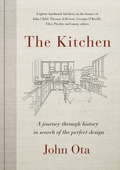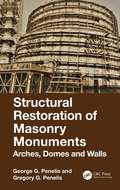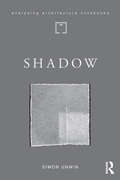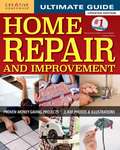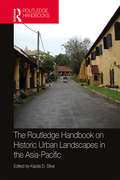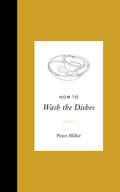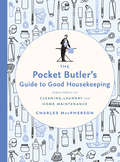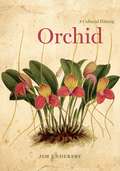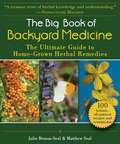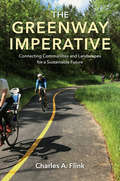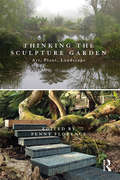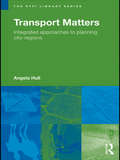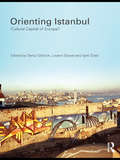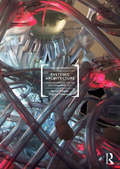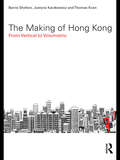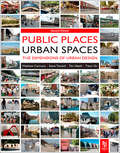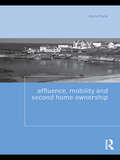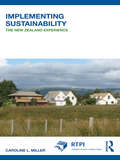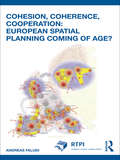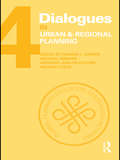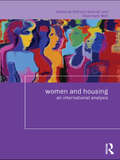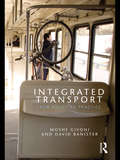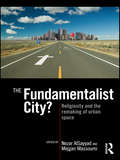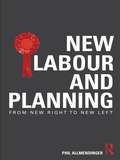- Table View
- List View
The Kitchen: A journey through time-and the homes of Julia Child, Georgia O'Keeffe, Elvis Presley and many others-in search of the perfect design
by John OtaOne man's quest to seek out--and be inspired by--the great historic kitchens of Canada and the USA.John Ota was a man on a mission--to put together the perfect kitchen. He and his wife had been making do with a room that was frankly no great advertisement for John's architectural expertise. It just about did the job but for a room that's supposed to be the beating heart of a home and a joy to cook in, the Otas' left a lot to be desired. And so John set out on a quest across North America, exploring examples of excellent designs throughout history, to learn from them and apply their lessons to his own restoration. Along the way, he learned about the origins and evolution of the kitchen, its architecture and its appliances. He cooked, with expert instruction. And he learned too about the homes and their occupants, who range from pilgrims to President Thomas Jefferson, from turn of the century tenement dwellers to 21st century Vancouver idealists, from Julia Child to Georgia O'Keeffe, and from Elvis Presley to Louis Armstrong. John Ota has a refreshingly upbeat approach and a hunger for knowledge (and indeed for food). His energy and enthusiasm are contagious, and his insights of lasting value. Illustrated throughout, with photographs and also with drawings by the author, this is a book for homeowners, home makers, interior designers, cooks, armchair historians, and for anyone who--like John Ota before them--is looking for inspiration for a renovation.
Structural Restoration of Masonry Monuments: Arches, Domes and Walls
by George G. Penelis Gregory G. PenelisHistoric structures need to be restored in line with international guidance and charters developed by architects and archaeologists, but technical understanding of structural engineering and materials is crucial, particularly with respect to response to earthquake loading. This guide to structural assessment and restoration of masonry monuments and historical buildings outlines the techniques, materials and design procedures used. It begins with principles, theory and practice and then presents case studies. The assessment focusses on Building materials and construction techniques used in the past The mechanics of masonry The structural behaviour of masonry monuments and historical buildings In-situ investigation and laboratory tests for existing and restoration materials. The restoration elaborates on Techniques and materials available for structural restoration Structural analysis and design Deciding on the restoration scheme Emergency measures and protective measures.
Shadow: the architectural power of withholding light (Analysing Architecture Notebooks)
by Simon UnwinEach of these Analysing Architecture Notebooks is devoted to a particular theme in understanding the rich and varied workings of architecture. They can be thought of as addenda to the foundation volume Analysing Architecture, which first appeared in 1997 and has subsequently been enlarged in three further editions. Examining these extra themes as a series of Notebooks, rather than as additional chapters in future editions, allows greater space for more detailed exploration of a wider variety of examples, whilst avoiding the risk of the original book becoming unwieldy. Shadows may be insubstantial but they are, nevertheless, an important element in architecture. In prehistoric times we sought shade as a refuge from the hot sun and chilling rain. Through history architects have used shadows to draw, to mould form, to paint pictures, to orchestrate atmosphere, to indicate the passing of time … as well as to identify place. Sometimes shadow can be the substance of architecture.
Home Repair And Improvement: 325 Step-by-step Projects, 3,300 Photos And Illustrations
by Creative Homeowner EditorsThe most complete home improvement manual on the market, this book offers more than 2,300 photos, 800 drawings, and understandable, practical text. Readers will find essential instruction on plumbing and electrical repairs, heating and cooling, roofing and siding, cabinets and countertops, and more. Information is also provided on tools, materials, and basic skills, plus 325 step-by-step projects with how-to photo sequences. The Ultimate Guide to Home Repair & Improvement also includes a remodeling guide and a resource guide. Top to bottom, inside and out, this is the single, ultimate resource book for home projects and repairs.
The Routledge Handbook on Historic Urban Landscapes in the Asia-Pacific (Routledge International Handbooks)
by Kapila SilvaThe Routledge Handbook on Historic Urban Landscapes in the Asia-Pacific sheds light onto the balancing act of urban heritage management, focusing specifically on the Asia-Pacific regions in which this challenge is imminent and in need of effective solutions. Urban heritage, while being threatened amid myriad forces of global and ecological change, provides a vital social, cultural, and economic asset for regeneration and sustenance of liveability of inhabited urban areas worldwide. This six-part volume takes a critical look at the concept of Historic Urban Landscapes, the approach that UNESCO promotes to achieve holistic management of urban heritage, through the lens of issues, prospects, and experiences of urban regeneration of the selected geo-cultural context. It further discusses the difficult task that heritage managers encounter in conceptualizing, mapping, curating, and sustaining the plurality, poetics, and politics of urban heritage of the regions in question. The connective thesis that weaves the chapters in this volume together reinforces for readers that the management of urban heritage considers cities as dynamic entities, palimpsests of historical memories, collages of social diversity, territories of contested identities, and sites for sustainable liveability. Throughout this edited collection, chapters argue for recognizing the totality of the eco-cultural urban fabric, embracing change, building social cohesion, and initiating strategic socio-economic progress in the conservation of Historic Urban Landscapes. Containing thirty-seven contributions written by leading regional experts, and illustrated with over 200 black and white images and tables, this volume provides a much-needed resource on Historic Urban Landscapes for students, scholars, and researchers.
How to Wash the Dishes
by Peter MillerFind order and beauty in the kitchen with this delightfully elegant primer on washing the dishes that elevates and illuminates a seemingly routine chore.Washing the dishes is an ordinary, everyday task--but with examination and care, it can become much more. In this reverent guide to the household chore, Peter Miller shows us how washing dishes can become a joy, a delight, a meditative exercise, and an act of grace and rhythm.We pay so much attention to recipes but little attention to maintenance and cleanup. Washing the dishes is as much a part of making a meal as prepping the vegetables, making the sauces, or seasoning the meats. At times it is quite routine, sometimes raucous, other times complex. It is never convenient. Despite its din and clatter, and despite its reputation, washing the dishes is the coda to the meal. It is a bustling musical of water and soap, of flow and surface, and done well, the fragile shall sit as proudly as the cast-iron.There are some who do the dishes for the clarity and privacy of it, and there are some who relish the quiet isolation of putting things in order where they belong. There are some who feel the time and movement is a kind of digestive. In the evening in particular, there is a silence when it is all done. How to Wash the Dishes brings elegance, art, and a bit of mindfulness to the sink. It is the perfect gift for those who love to clean and equally as apt for those we wish would clean a bit more.
The Pocket Butler's Guide to Good Housekeeping: Expert Advice on Cleaning, Laundry and Home Maintenance (Pocket Butler)
by Charles MacPhersonEveryone's favourite butler is back! Get your home spic and span with Charles MacPherson's expert tips and tricks for everything from polishing silverware to organizing the garage.After over 30 years as a professional butler and household manager, Charles MacPherson knows a thing or two about keeping a home clean and organized. He has poured his vast knowledge and expertise into this pocket-sized volume, perfect for easy day-to-day reference or to guide your next marathon cleaning session.Everything you need to know is here. With step-by-step instructions for cleaning, organizing, and maintaining every room in your home, The Pocket Butler's Guide to Housekeeping comprises information-packed chapters on cleaning, laundry, organization, and more. Wondering how to tackle a fresh stain? Looking for recipes for natural and gentle cleaning products? Want to finally master those crisp hospital corners for making your bed? Look no further than this definitive cleaning caddy companion.With handy checklists for daily, weekly, monthly, and annual cleaning; a complete guide to laundry symbols and fabric types; advice for hosting guests; and even tips for dealing with pests, damage, and long-term maintenance, this is a volume no home should be without.
Rock Your Rental: Style, Design, And Marketing Tips To Boost Your Bookings
by Joanne Palmisano Rosanne PalmisanoA fun how-to guide to help vacation rental owners create big designs on small budgets By 2020, vacation rentals are expected to surpass the hotel industry. But with so much competition, how do property owners stand out? In Rock Your Rental, the Palmisano sisters offer their unique design ideas to upgrade your space from sometimes-booked to a sought-after lodging destination. Full of inspiration, DIY projects, marketing tips, and gorgeous before-and-after photos, this book is essential reading for innkeepers, bed-and-breakfast owners, and hotel hosts—and especially for vacation rental owners who use sites such as Airbnb, VRBO, HomeAway, and Booking.com. A witty, go-to handbook with actionable tips, examples, and ideas, Rock Your Rental is an essential resource for property owners who want to increase their bookings, profits, and the happiness of their customers.
Orchid: A Cultural History
by Jim EndersbyAt once delicate, exotic, and elegant, orchids are beloved for their singular, instantly recognizable beauty. Found in nearly every climate, the many species of orchid have carried symbolic weight in countless cultures over time. The ancient Greeks associated them with fertility and thought that parents who ingested orchid root tubers could control the sex of their child. During the Victorian era, orchids became deeply associated with romance and seduction. And in twentieth-century hard-boiled detective stories, they transformed into symbols of decadence, secrecy, and cunning. What is it about the orchid that has enthralled the imagination for so many centuries? And why do they still provoke so much wonder? Following the stories of orchids throughout history, Jim Endersby divides our attraction to them into four key themes: science, empire, sex, and death. When it comes to empire, for instance, orchids are a prime example of the exotic riches sought by Europeans as they shaped their plans for colonization. He also reveals how Charles Darwin's theory of evolution became intimately entangled with the story of the orchid as he investigated their methods of cross-pollination. As he shows, orchids--perhaps because of their extraordinarily diverse colors, shapes, and sizes--have also bloomed repeatedly in films, novels, plays, and poems, from Shakespeare to science fiction, from thrillers to elaborate modernist novels. Featuring many gorgeous illustrations from the collection of the Royal Botanic Gardens, Kew, Orchid: A Cultural History tells, for the first time, the extraordinary story of orchids and our prolific interest in them. It is an enchanting tale not only for gardeners and plant collectors, but anyone curious about the flower's obsessive hold on the imagination in history, cinema, literature, and more.
The Big Book of Backyard Medicine: The Ultimate Guide to Home-Grown Herbal Remedies
by Julie Bruton-Seal Matthew SealThe Most Thorough Compilation of Home Cures and Remedies Yet! Years ago, every household practiced natural healing by using what they had. Plants grow abundantly all over our roadsides, cities, and in your own backyard, and though once valued and widely used, they've fallen out of fashion over time as people forget the numerous medicinal uses at our fingertips. This book brings alternative medicine back to the forefront. Researched and written by a practicing medical herbalist and natural healer, and now with even more herbs and medicinal plants, The Big Book of Backyard Medicine is the basis for a veritable natural pharmacy that anyone can create. Featuring one hundred specific plants and their associated remedies, and fully illustrated with hundreds of color photographs, this book offers fascinating insights into the literary, historic, botanical, and global applications of common wild plants and herbs that can be used in medicines, including: AshChicoryDandelionForget-me-notGypsywortHorseradishMintRed PoppyThistleWild carrotWillowAnd so much more! Anyone who wants to improve his or her health in a completely natural way will find this book to be an absolute must-have for his or her home—and garden.
The Greenway Imperative: Connecting Communities and Landscapes for a Sustainable Future
by Charles A. FlinkTrailblazing greenway projects from vision to reality In this eye-opening journey through some of America’s most innovative landscape architecture projects, Charles Flink shows why we urgently need greenways. A leading authority in greenway planning, design, and development, Flink presents inspiring examples of communities that have come together to build permanent spaces for the life-sustaining power of nature. The Greenway Imperative reveals the stories behind a variety of multiuse natural corridors, taking readers to Grand Canyon National Park, suburban North Carolina, the banks of the Miami River, and many other settings. Flink, who was closely involved with each of the projects in this book during his 35-year career, introduces the people who jumpstarted these initiatives and the challenges they overcame in achieving them. Flink explains why open green spaces are increasingly critical today. “Much more than a path through the woods,” he says, greenways conserve irreplaceable real estate for the environment, serve as essential green infrastructure, shape the way people travel within their communities, reduce impact from flooding and other natural disasters, and boost the economies of cities and towns. Greenways can and should dramatically reshape the landscape of America in the coming years, Flink argues. He provides valuable reflections and guidance on how we can create resilient communities and satisfy the human need for connection with the natural world.
Thinking the Sculpture Garden: Art, Plant, Landscape
by Penny FlorenceThis innovative book poses two, deceptively simple, questions: what is a sculpture garden, and what happens when you give equal weight to the main elements of landscape, planting and artwork? Its wide-ranging frame of reference, including the USA, Europe and Japan, is brought into focus through Tremenheere Sculpture Garden, Cornwall, with which the book begins and ends. Effectively less than 15 years old, and largely the work of one man, Tremenheere affords an opportunity to examine as work-in-progress the creation of a new kind of sculpture garden. Including a historical overview, the book traverses multiple ways of seeing and experiencing sculpture gardens, culminating in an exploration of their relevance as 'cultural ecology' in the context of globalisation, urbanisation and climate change. The thinking here is non-dualist and broadly aligned with New Materialisms and Material Feminisms to explore our place as humans in the non-human world on which we depend. Eminent contributors, including John Dixon Hunt, George Descombes, Bernard Lassus and David Leatherbarrow, approach these issues through practices and theories of landscape architecture; garden and art making; history and writing; and philosophy. Richly illustrated with over 100 images, including a colour plate section, the book will primarily appeal to those engaged in professional or academic research, along with sculpture garden visitors, who will find new and surprising ways of experiencing plants and art in natural and urban settings.
Transport Matters: Integrated Approaches to Planning City-Regions (RTPI Library Series)
by Angela HullAddressing the principles of sustainability, spatial planning, integration, governance and accessibility of transport, this book focuses on the problem of providing efficient and low energy transport systems which serve the needs of everybody. It explores many of the new arguments, ideas and perceptions of mobility and accessibility in city-regions. Looking at evidence from Denmark, Sweden, The Netherlands, Germany and the UK, it considers the meaning of the key concepts of sustainable accessibility, the spatial planning model, and integrated territorial policies.
Orienting Istanbul: Cultural Capital of Europe? (Planning, History and Environment Series)
by Deniz GöktürkLooking at the globalization, urban regeneration, arts events and cultural spectacles, this book considers a city not until now included in the global city debate. Divided into five parts, each preceded by an editorial introduction, this book is an interdisciplinary study of an iconic city, a city facing conflicting social, political and cultural pressures in its search for a place in Europe and on the world stage in the twenty-first century.
Systemic Architecture: Operating Manual for the Self-Organizing City
by Marco Poletto Claudia PasqueroThis is a manual investigating the subject of urban ecology and systemic development from the perspective of architectural design. It sets out to explore two main goals: to discuss the contemporary relevance of a systemic practice to architectural design, and to share a toolbox of informational design protocols developed to describe the city as a territory of self-organization. Collecting together nearly a decade of design experiments by the authors and their practice, ecoLogicStudio, the book discusses key disciplinary definitions such as ecologic urbanism, algorithmic architecture, bottom-up or tactical design, behavioural space and the boundary of the natural and the artificial realms within the city and architecture. A new kind of "real-time world-city" is illustrated in the form of an operational design manual for the assemblage of proto-architectures, the incubation of proto-gardens and the coding of proto-interfaces. These prototypes of machinic architecture materialize as synthetic hybrids embedded with biological life (proto-gardens), computational power, behavioural responsiveness (cyber-gardens), spatial articulation (coMachines and fibrous structures), remote sensing (FUNclouds), and communication capabilities (Ecological Footprint Grotto). Supporting the authors’ own essays and projects are contributions from key innovators in contemporary architecture and urban design: Michael Batty, Andrew Hudson-Smith, Michael Weinstock and Patrik Schumacher.
The Making of Hong Kong: From Vertical to Volumetric (Planning, History and Environment Series)
by Barrie Shelton Justyna Karakiewicz Thomas KvanThis book investigates what the history of Hong Kong’s urban development has to teach other cities as they face environmental challenges, social and demographic change and the need for new models of dense urbanism. The authors describe how the high-rise intensity of Hong Kong came about; how the forest of towers are in fact vertical culs de sac; and how the city might become truly ‘volumetric’ with mixed activities through multiple levels and 3D movement networks incorporating ‘town cubes’ rather than town squares. For more information, visit the authors' website: http://www.makingofhk.com/makingofhk.swf
Public Places - Urban Spaces
by Tim Heath Taner Oc Steve TiesdellPublic Places Urban Spaces, 2e, is a thorough introduction to the principles of urban design theory and practice. Authored by experts in the fields of urban design and planning, it is designed specifically for the 2,500 postgraduate students on Urban Design courses in the UK, and 1,500 students on undergraduate courses in the same subject.The 2e of this tried and trusted textbook has been updated with relevant case studies to show students how principles have been put into practice. The book is now in full color and in a larger format, so students and lecturers get a much stronger visual package and easy-to-use layout, enabling them to more easily practically apply principles of urban design to their projects.Sustainability is the driving factor in urban regeneration and new urban development, and the new edition is focused on best sustainable design and practice. Public Places Urban Spaces is a must-have purchase for those on urban design courses and for professionals who want to update and refresh their knowledge.
Affluence, Mobility and Second Home Ownership (Housing and Society Series)
by Chris ParisDespite the current recession, the frequency of second home ownership is still surprisingly high throughout the western world. While the UK and Ireland previously had lower occurrences of multiple dwellings compared to the rest of Europe, they are quickly catching up with a current surge in the ownership of second homes. The recent MP expenses scandal in the UK has also drawn attention to the prevalence of second homes (or more) within the middle classes, and the fact that the concept is becoming increasingly popular. Chris Paris uses this text to address the reasons behind why second homes are becoming more popular, both within the usual domicile of the individuals, and in international locations. The socioeconomic factors and historical contexts of homes in cultures across the world are fundamental to explaining the choices in transnational home ownership, and Paris’ case studies and comparisons between additional homes in Europe, Australia, America and Asia expand upon the motivation for people to own a second home. Affluence, Mobility and Second Home Ownership draws together debates on gentrification, globalisation, consumerism, environmental factors and investment to provide a balanced look at the pros, and cons, of second home ownership, and what implications it has for the future. An ideal text for students studying geography, urbanism and planning, this book is also of interest to individuals interested in the changing ways in which we make choices on our places of residence.
Implementing Sustainability: The New Zealand Experience (RTPI Library Series)
by Caroline L. MillerNew Zealand’s Resource Management Act (RMA) was hailed as a radical new approach to planning that would both achieve better environmental outcomes and benefit developers by working rapidly and more efficiently. This book examines the lessons that can be learned by planning practitioners across the world. It focuses on the realities of implementing the RMA for the planning profession, the community and the political system within which planning must always operate. Offering a practitioner’s insight, the book looks at those strategies and techniques that have proved successful, and spells out what can be applied to the planning systems of other countries.
Cohesion, Coherence, Cooperation: European Spatial Planning Coming Of Age? (RTPI Library Series)
by Andreas FaludiSince its foundation the European Union has gradually developed policies that are aimed at achieving increased economic and social cohesion. This book examines the most recent of these, the concept of territorial cohesion. Territorial cohesion is the pursuit of balanced development, competitiveness, sustainable development, and good governance. These concerns are most readily addressed by the formulation of spatial strategies under the umbrella of spatial planning, that brings together a multitude of public and private actors in a process that requires cohesion, coherence and co-operation. This book traces the development of spatial planning at European level and argues that spatial planning can become a vehicle, not only for territorial cohesion, but for EU policy generally.
Dialogues in Urban and Regional Planning: Volume 4
by Thomas L. HarperDialogues in Urban and Regional Planning, Volume 4 is a selection of some of the best scholarship in urban and regional planning from around the world. The internationally recognized authors of these award-winning papers take up a range of salient issues from the theory and practice of planning. The topics they address include planning and governance in Zimbabwe, rebuilding after Hurricane Katrina, safety issues in urban spaces, and an analysis of French transportation policies. The breadth of the topics covered in this book will appeal to all those with an interest in urban and regional planning, providing a springboard for further debate and research. The papers focus particularly on how planning institutions can meet contemporary environmental, demographic, economic, and socio-spatial challenges. The Dialogues books are published in association with the Global Planning Education Association Network (GPEAN) and its member planning schools associations. These associations represent 360 planning schools in nearly fifty countries around the globe. They have selected these papers based on regional competitions.
Women and Housing: An International Analysis (Housing and Society Series)
by Patricia KennettIn the context of contemporary economic, political, social and cultural transformations, this book brings together contributions from developed and emerging societies in Europe, the USA and East Asia in order to highlight the nature, extent and impact of these changes on the housing opportunities of women. The collection seeks to contribute to comparative housing debates by highlighting the gendered nature of housing processes, locating these processes within wider structured and institutionalized relations of power, and to show how these socially constructed relationships are culturally contingent, and manifest and transform over time and space. The international contributors draw on a wide range of empirical evidence relating to labour market participation, wealth distribution, family formation and education to demonstrate the complexity and gendered nature of the interlocking arenas of production, reproduction and consumption and the implications for the housing opportunities of women in different social contexts. Worldwide examples are drawn from Australia, China, Great Britain, Hong Kong, Japan, Spain, Sweden, Taiwan and the USA.
Integrated Transport: From Policy to Practice
by Moshe Givoni David BanisterTravel is an essential part of everyday life and today most journeys are multimodal. It is the total travel experience that counts and integrated transport must reduce the inconvenience of transfers between modes. Most research and many publications on transport policy advocate sustainable transport, but the priority given to integration has been negligible. Yet integration is one of the most important means to advance sustainable transport and sustainability more generally. While integrated transport systems are seen to be an ideal, there is a failure to make the transition from policy to practice. The authors argue that the achievement of sustainable transport is still a dream, as an integrated transport policy is a prerequisite for a sustainable transport system. It is only when the two concepts of sustainability and integration operate in the same direction and in a positive way that real progress can be made. In this book, transportation experts from across the world have addressed the questions about what is integration, why is it so important and why is it so hard to achieve? The book provides an in-depth analysis of these issues and it aims to provide a better understanding of the subject, about what should be strived for, about what is realistic to expect, and about how to move forward towards a more integrated provision of transport infrastructure, services and management.
The Fundamentalist City?: Religiosity and the Remaking of Urban Space
by Nezar AlSayyadThe relationship between urbanism and fundamentalism is a very complex one. This book explores how the dynamics of different forms of religious fundamentalisms are produced, represented, and practiced in the city. It attempts to establish a relationship between two important phenomena: the historic transition of the majority of the world’s population from a rural to an urban existence; and the robust resurgence of religion as a major force in the shaping of contemporary life in many parts of the world. Employing a transnational interrogation anchored in specific geographic regions, the contributors to this volume explore the intellectual and practical challenges posed by fundamentalist groups, movements, and organizations. They focus on how certain ultra religious practices of Christianity, Hinduism, Islam, and Judaism have contributed to the remaking of global urban space. Their work suggests that it is a grave oversimplification to view religious orthodoxies or doctrines as the main cause of urban terrorism or violence. Instead they argue that such phenomena should be understood as a particular manifestation of modernity’s struggles. Nezar AlSayyad and Mejgan Massoumi’s book provides fascinating reading for those interested in religion and the city, with thought provoking pieces from experts in anthropology, geography sociology, religious studies, and urban studies.
New Labour and Planning: From New Right to New Left
by Phil AllmendingerFollowing the Thatcher and Major administrations there was an apparent renaissance of planning under New Labour. After a slow start in which Labour’s view of planning owed more to a neo-liberal, rolled back state model reminiscent of the New Right the Government began to appreciate that many of its wider objectives including economic development, climate change, democratic renewal, social justice and housing affordability intersected with and were critically dependent upon the planning system. A wide range of initiatives, management processes, governance vehicles and policy documents emanated from Government. Planning, like other areas of the public sector, was to be reformed and modernised as well as given a prime role in tackling national, high profile priorities such as increasing housing supply and improving economic competitiveness. Drawing upon an institutionalist framework the book also seeks to understand how and in what circumstances change emerges, either in an evolutionary or punctuated way. It will, for the first time, chart and explore the changing nature of development and planning over the Labour era whilst also stepping back and reflecting upon what such changes mean for planning generally and the likely future trajectories of reform and spatial governance.
